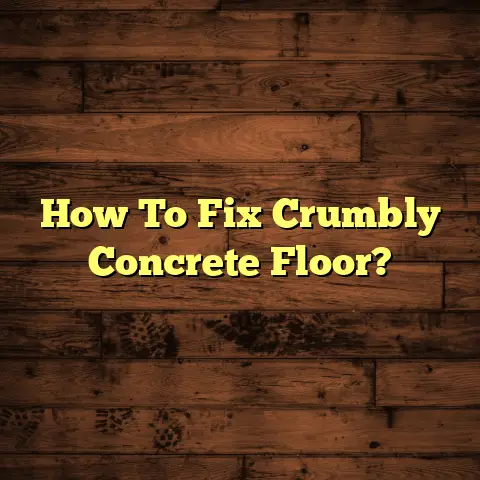Floor Tiles Popping Up? (1-Day Fix!)
Hey everyone, it’s your friendly neighborhood flooring contractor here! Let me tell you a story.
A few years back, I walked into my own kitchen and heard this click sound. I ignored it at first, thinking it was just the house settling. But then it happened again, and again.
I looked down, and to my horror, one of my beautiful ceramic tiles was slightly raised! My initial reaction? Panic. A wave of “Oh no, not now!” washed over me.
I’m a flooring guy, for crying out loud! My own floor was betraying me.
The frustration was real, but I knew I had to tackle it head-on. I’m here to tell you that popping tiles are a common problem, and you don’t need to freak out.
Whether you’ve got ceramic, porcelain, or even stone tiles, this can happen. And the good news? You can often fix it yourself in just one day.
In this article, I’m going to walk you through the whole process, from understanding why tiles pop up in the first place, to the exact steps you need to take to get your floor back to normal.
Let’s get started!
Section 1: Understanding the Problem
So, what’s the deal with tiles suddenly deciding to become rebellious and pop up? There are several reasons why this happens.
What Causes Floor Tiles to Pop Up?
-
Moisture Issues: This is a big one. Water seeping under the tiles can weaken the adhesive or mortar. This can lead to loss of bond and eventually, the tile pops. Think leaky pipes, spills that aren’t cleaned up quickly, or even high humidity.
-
Poor Installation: I hate to say it, but sometimes it’s just a bad job. If the subfloor wasn’t properly prepared, or the wrong adhesive was used, the tiles won’t bond correctly. According to the Tile Council of North America (TCNA), proper subfloor preparation is crucial for a long-lasting tile installation.
-
Temperature Changes: Tiles expand and contract with temperature fluctuations. If the expansion joints aren’t properly installed, the tiles can push against each other, causing them to pop up. Ever notice it more in the winter?
-
Settling of the House: Houses settle over time, and this can put stress on the tiles. Minor settling is normal, but major shifts can definitely cause problems.
Now, let’s talk about the two main ways tiles are installed:
-
Glued Tiles: These are typically smaller tiles, like mosaics or some ceramic tiles, that are directly glued to the subfloor with adhesive.
-
Mortar-Set Tiles: These are usually larger tiles, like porcelain or stone, that are set in a bed of mortar.
Glued tiles are generally more susceptible to moisture issues because the adhesive layer is thinner. Mortar-set tiles are a bit more resilient, but they can still pop up if the mortar bed is compromised.
Signs of Popped Tiles
It’s not always obvious when a tile is about to pop. Here are some things to look out for:
-
Creaking Sounds: This is a classic sign. If you hear a creak or crunch when you walk over a certain area, it’s likely a loose tile.
-
Hollow Sound: Tap on the tile. If it sounds hollow compared to the surrounding tiles, it’s probably lost its bond.
-
Visible Gaps: Check the grout lines around the tiles. If you see any cracks or gaps, it could be a sign that the tile is shifting.
-
Unevenness: Run your hand over the tiles. If you feel any slight bumps or dips, it could be a popped tile.
Why Immediate Action is Important
Ignoring popped tiles is like ignoring a toothache – it’s only going to get worse. Here’s why you need to address it ASAP:
-
Further Damage: A loose tile can damage the surrounding tiles. It can also allow moisture to seep into the subfloor, leading to rot and mold.
-
Increased Costs: The longer you wait, the more extensive the damage will be, and the more expensive it will be to fix. What starts as a simple re-setting can turn into a full floor replacement.
-
Safety Hazards: A popped tile can be a tripping hazard, especially for kids or elderly folks. Don’t risk an injury!
Section 2: Tools and Materials Needed for the Fix
Alright, let’s get down to the nitty-gritty. Here’s what you’ll need to tackle this project:
-
Tile Adhesive or Mortar: This is the stuff that will re-bond the tile to the subfloor. For small tiles, a pre-mixed tile adhesive is usually fine. For larger tiles, you’ll want to use a thin-set mortar. Check the manufacturer’s recommendations for your specific type of tile. I often use a modified thin-set mortar for most applications, like the ones from Custom Building Products or Mapei.
-
Trowel: You’ll need a notched trowel to apply the adhesive or mortar evenly. The size of the notch depends on the size of your tile. Again, check the manufacturer’s recommendations.
-
Grout (if necessary): If the grout around the popped tile is damaged, you’ll need to replace it. Choose a grout that matches your existing grout color.
-
Tile Cutter (if tiles need to be replaced): If the tile is cracked or broken, you’ll need to replace it. A wet saw is ideal for cutting tiles, but a snap cutter can work for smaller jobs.
-
Safety Gear: Gloves and safety goggles are a must. You don’t want to get adhesive or mortar in your eyes or on your skin.
-
Measuring Tape and Level: You’ll need these to make sure the tile is properly aligned and level.
-
Clean Cloths and a Bucket: For cleaning up spills and excess adhesive or mortar.
-
Putty Knife or Chisel: For gently removing the old adhesive or mortar.
-
Hammer: For gently tapping the tile into place.
-
Grout Float: For applying grout.
-
Grout Sponge: For cleaning up excess grout.
Section 3: Step-by-Step Guide to Fixing Popped Tiles
Okay, here’s the step-by-step process. Take your time, be patient, and you’ll be surprised at how easy it is.
Preparation
-
Clear the Area: Remove any furniture or rugs from the area around the popped tile. You need plenty of space to work.
-
Clean the Area: Sweep and vacuum the area to remove any dirt or debris. You want a clean surface to work with.
-
Identify the Affected Tiles: Carefully inspect the surrounding tiles to see if any others are loose. It’s better to fix them all at once.
Removing the Popped Tile
-
Protect Surrounding Tiles: Use painter’s tape to protect the surrounding tiles from damage.
-
Loosen the Tile: Use a putty knife or chisel to gently loosen the grout around the tile. Be careful not to damage the surrounding tiles.
-
Remove the Tile: Gently pry up the tile with the putty knife or chisel. If it’s really stuck, you may need to use a hammer to tap the putty knife. Work slowly and carefully to avoid breaking the tile.
-
Clean the Tile: If you’re reusing the tile, clean off any old adhesive or mortar with the putty knife.
Inspecting the Subfloor
-
Check for Moisture: Look for any signs of moisture damage, such as discoloration, mold, or rot. If you find moisture, you’ll need to address the source of the leak before you can repair the tile. According to the IICRC (Institute of Inspection, Cleaning and Restoration Certification), addressing moisture issues is crucial for preventing future problems.
-
Clean the Subfloor: Scrape away any old adhesive or mortar from the subfloor. You want a clean, level surface for the new adhesive or mortar.
-
Repair the Subfloor (if necessary): If the subfloor is damaged, you’ll need to repair it before you can install the new tile. This may involve patching holes or cracks with a cement-based patching compound.
Applying Adhesive or Mortar
-
Mix the Mortar (if using): Follow the manufacturer’s instructions for mixing the mortar. You want a consistency that’s similar to peanut butter.
-
Apply the Adhesive or Mortar: Use the notched trowel to apply a thin, even layer of adhesive or mortar to the subfloor. Hold the trowel at a 45-degree angle and create ridges in the adhesive or mortar.
-
Don’t Overdo It: Use the right amount of adhesive/mortar. Too much and the tile will be uneven. Too little and it won’t bond properly.
Reinstalling the Tile
-
Place the Tile: Carefully place the tile back into the opening, aligning it with the surrounding tiles.
-
Press Firmly: Press down firmly on the tile to ensure it’s fully seated in the adhesive or mortar.
-
Check for Level: Use a level to make sure the tile is flush with the surrounding tiles. If it’s not, gently tap it down with a hammer.
-
Remove Excess Adhesive/Mortar: Wipe away any excess adhesive or mortar that squeezes out around the edges of the tile.
-
Use Tile Spacers (if necessary): If you’re working with multiple tiles, use tile spacers to ensure consistent grout lines.
Grouting and Finishing Touches
-
Let the Adhesive/Mortar Cure: Allow the adhesive or mortar to cure for at least 24 hours before grouting.
-
Mix the Grout: Follow the manufacturer’s instructions for mixing the grout.
-
Apply the Grout: Use a grout float to apply the grout to the grout lines around the tile. Press the grout firmly into the joints.
-
Remove Excess Grout: Use a damp grout sponge to wipe away any excess grout from the surface of the tile.
-
Let the Grout Cure: Allow the grout to cure for at least 24 hours.
-
Buff the Tile: Use a clean, dry cloth to buff the tile and remove any remaining grout haze.
Final Inspection
-
Check for Loose Tiles: After the grout has cured, check the tile to make sure it’s firmly in place.
-
Clean the Area: Sweep and vacuum the area to remove any remaining debris.
Section 4: Preventive Measures to Avoid Future Issues
Okay, you’ve fixed the problem. Now, let’s talk about how to prevent it from happening again.
-
Regular Inspections for Moisture Issues: Keep an eye out for any signs of leaks or spills. Address them promptly.
-
Maintain Indoor Humidity Levels: High humidity can contribute to moisture problems. Use a dehumidifier in damp areas, like bathrooms and basements. According to the EPA (Environmental Protection Agency), maintaining indoor humidity levels between 30-50% can help prevent mold growth.
-
Professional Installation for New Tiles: If you’re installing new tiles, hire a qualified professional. A proper installation is key to preventing future problems.
-
Ensure Proper Ventilation: Make sure bathrooms and kitchens are well-ventilated. Use exhaust fans when showering or cooking.
-
Use Quality Materials: Don’t skimp on the adhesive or mortar. Use high-quality materials that are designed for your specific type of tile.
-
Consider Expansion Joints: When installing new tiles, be sure to include expansion joints. These allow the tiles to expand and contract without putting stress on the surrounding tiles.
Conclusion
So, there you have it! Fixing popped tiles is a manageable DIY project. It might seem daunting at first, but with the right tools, materials, and a little patience, you can get your floor back to normal in just one day.
Remember that click sound I heard in my kitchen? Well, after a few hours of work, I had that tile back in place, and the clicking was gone. The satisfaction of fixing it myself was immense.
Don’t let popped tiles stress you out. Take action, follow these steps, and you’ll be back on solid ground in no time!
Call to Action
Have you ever dealt with popped tiles? What was your experience? Share your tips and tricks in the comments below! Let’s learn from each other and create a community of confident home repair heroes.
And if you have any questions, feel free to ask! I’m here to help.





